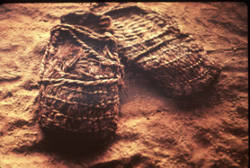Northern Great Basin Prehistory Project
Archaeological Field School
2018 Summer Session
History of the Field School
The University of Oregon summer archaeological field school was established in 1937 by Luther S. Cressman, who is known as the father of Oregon archaeology. In 1938 the field school, excavating at Fort Rock Cave in Central Oregon's Northern Great Basin, recovered many sagebrush bark sandals from below a layer of volcanic ash. The ash was laid down nearly 7600 years ago by the climatic eruption of Mount Mazama that created Crater Lake in the southern Cascades. The Fort Rock type sagebrush sandals have since proved through radiocarbon dating to be more than 10,000 years old.

Photo by Steve Bodini
This evidence, and other data gathered in pioneering applications of multidisciplinary research in archaeology, allowed Cressman to demonstrate that humans have been living in the Great Basin much longer than previously thought. Since Cressman's time, the UO has maintained an active program of research and training in archaeology.
For the past 26 years, the University of Oregon field school has returned annually to the Northern Great Basin to resume Cressman's earlier research. The ongoing work of the Northern Great Basin Prehistory Project Archaeology Field School emphasizes reconstruction of past lifeways, paleoclimatic investigations, and human responses to changing environmental conditions.